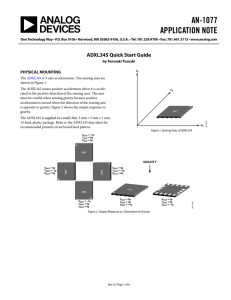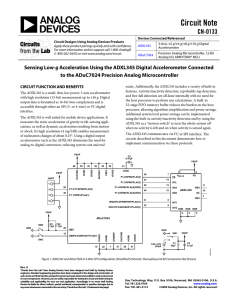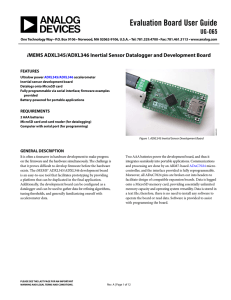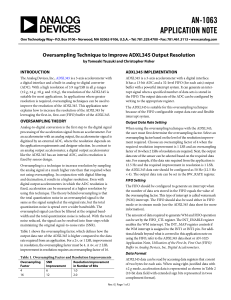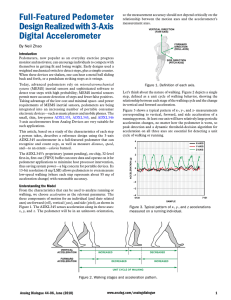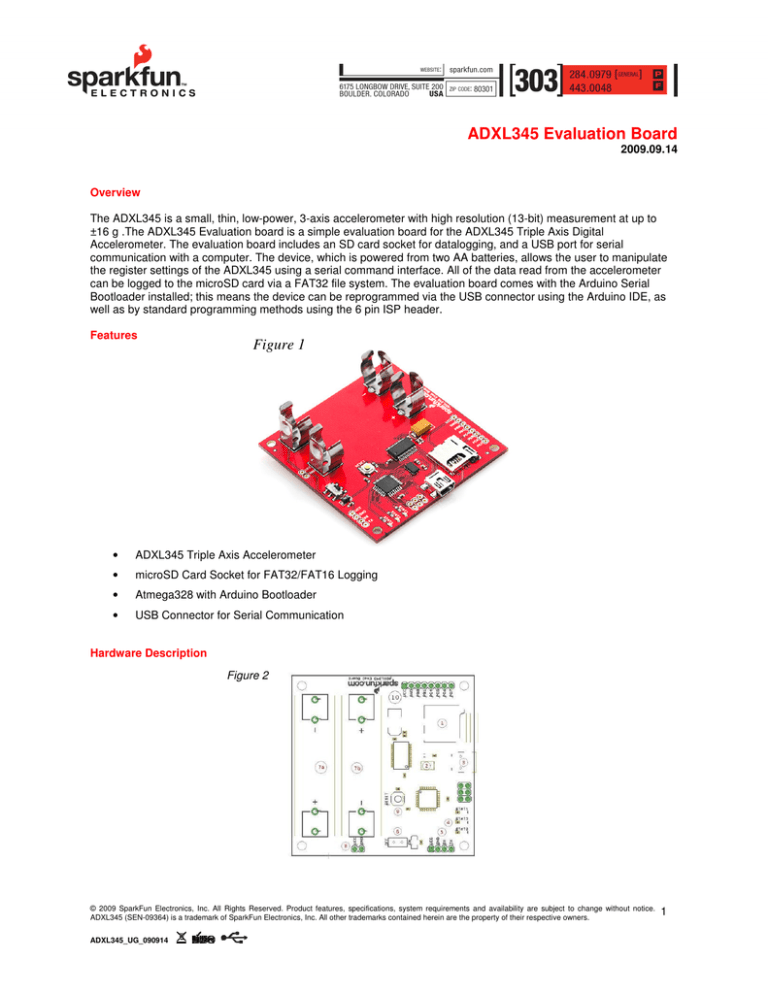
ADXL345 Evaluation Board
2009.09.14
Overview
The ADXL345 is a small, thin, low-power, 3-axis accelerometer with high resolution (13-bit) measurement at up to
±16 g .The ADXL345 Evaluation board is a simple evaluation board for the ADXL345 Triple Axis Digital
Accelerometer. The evaluation board includes an SD card socket for datalogging, and a USB port for serial
communication with a computer. The device, which is powered from two AA batteries, allows the user to manipulate
the register settings of the ADXL345 using a serial command interface. All of the data read from the accelerometer
can be logged to the microSD card via a FAT32 file system. The evaluation board comes with the Arduino Serial
Bootloader installed; this means the device can be reprogrammed via the USB connector using the Arduino IDE, as
well as by standard programming methods using the 6 pin ISP header.
Features
Figure 1
•
ADXL345 Triple Axis Accelerometer
•
microSD Card Socket for FAT32/FAT16 Logging
•
Atmega328 with Arduino Bootloader
•
USB Connector for Serial Communication
Hardware Description
Figure 2
© 2009 SparkFun Electronics, Inc. All Rights Reserved. Product features, specifications, system requirements and availability are subject to change without notice.
ADXL345 (SEN-09364) is a trademark of SparkFun Electronics, Inc. All other trademarks contained herein are the property of their respective owners.
ADXL345_UG_090914
1
ADXL345 Evaluation Board
2009.09.14
The image above shows the component layout of the ADXL345 Evaluation Board. Here is a list describing the
important hardware features of the device:
1)
SD Card Socket – Any FAT32 microSD card can be inserted into the SD Card Socket.
2)
ADXL345 Triple Axis Accelerometer
3)
USB Connector – Connect a USB cable from a computer to interact with the Evaluation Board
4)
Status LEDs – The behavior of the Status LEDs is described later in the document.
5)
UART Pins – TTL level serial communication can be accessed through these pins.
6)
Power Switch – Power to the device is controlled with this switch.
7)
AA Battery Clips – The device runs off of two AA batteries inserted in these clips. Double check the battery
orientation before turning the device on.
8)
Power Header – The evaluation board may also be plugged into the two pin power header. Do not exceed
3.3V or the ADXL345 chip may be damaged. You can also access the battery voltage to provide power to
external devices from these pins.
9)
Reset Button – Pressing this button will reset the evaluation board. (Note: Resetting the device will cause
the current log file to be closed, and a new one will be created at startup.)
10) External I/O Header – The spare pins from the Atmega328 are available on this header, along with access
to the board’s power and ground signals. These pins may be used to interact with external hardware if
custom firmware is created for the evaluation board.
Powering the ADXL345 Evaluation Board
The ADXL345 Evaluation Board can (and should) be powered by two AA batteries. These two batteries, connected in
a serial configuration in the hardware, provide the board with roughly 3 volts. If you choose not to power the device
using two AA batteries, it is recommended you provide between 3 and 3.3 Volts to power the board.
Operation
Startup Operation
When the device is powered on the default firmware will run with adequate functionality. At power up, the board will
cycle all three status LEDs on and off. Next the device checks for the presence of a FAT16 or FAT32 formatted
microSD card in the SD card socket. If a card is found, then the card is initialized, datalogging is enabled and all three
status LEDs will blink on and off four times; if no card is found (or an unformatted card is in the socket) then
datalogging is disabled and all three LEDs will blink on and off two times. If a formatted card was found then a new
log file is created. The log files are created with file names in the format 'ADXL345_XXX.csv.' The XXX is a 3 digit
number that increments every time a new file is created. So if no files exist on the SD card, the first file created would
be 'ADXL345_000.csv' and the next file created would be 'ADXL345_001.csv' and so on. However, the number that
follows 'ADXL345_' is will always be the lowest available number that is not already present on the SD card; so if
you've deleted some log files from the SD card but left others on the card be careful to note what the newest log files'
number will be.
After the device determines whether or not datalogging is enabled the ADXL345 Accelerometer is initialized. The
accelerometer is initialized to log data at 100 Hz with +/- 2g range. The initialization also inverts the Interrupt Bit in the
Data Format register so that interrupts generate an Active Low signal on the INT pins, and the Data Ready interrupt is
enabled and mapped to the INT1 pin. Below is a list of the ADLX345 registers that are changed from their default
values on initialization. The ADXL345 Evaluation Board will always initialize the accelerometer to these values at
startup (as long as custom firmware is not loaded), regardless of if the user changes the register settings using the
© 2009 SparkFun Electronics, Inc. All Rights Reserved. Product features, specifications, system requirements and availability are subject to change without notice.
ADXL345 (SEN-09364) is a trademark of SparkFun Electronics, Inc. All other trademarks contained herein are the property of their respective owners.
ADXL345_UG_090914
2
ADXL345 Evaluation Board
2009.09.14
command interface. After the ADXL345 registers are initialized, the accelerometer is put into measurement mode.
Figure 3
ADXL345 Register (Hex Address)
Initialization Value (Different than the registers
'default' value)
Data Format(0x31)
0x20
Interrupt Enable (0x2E)
0x80
Once the accelerometer is put into measurement mode the evaluation board begins logging accelerometer data from
all three axis to the log file at 100 Hz. Data is logged to the csv file in the format 'XXXX\tYYYY\tZZZZ\n.' That is 4
characters representing the integer value of the accelerometer reading are logged for each axis. The X value is
logged first, followed by a 'TAB' character and the Y value, followed by another 'TAB' character and then the Z value,
finally the log is finished with the New Line character. The measurement rate is determined by the ADXL345 registers
and can be changed by modifying the BW_RATE register value. The maximum bandwidth that the evaluation board
supports using the default firmware is 200 Hz. This limitation is imposed by the UART (set to 57600 bps) and can be
changed by writing custom firmware that bypasses the printing statements that occur after every reading.
Once the accelerometer enters the logging mode, logging will continue until either the device is turned off, reset, or
the user interrupts the logging mode by using the command interface. The command interface provides the user with
a means of changing the register values of the ADXL345 through a serial command set. The command interface will
be covered in depth in the next section.
There are three status LEDs on board the ADXL345 Evaluation Board. The STAT1 LED (Red), is used to tell the user
when data is logged to the SD card. Every time the device logs a buffer to the SD card, the LED will flash on and off.
The STAT2 and STAT3 LEDs are used to indicate to the user when the ADXL345 triggers an interrupt on the INT1
and INT2 pins respectively. By default, the Data Ready interrupt is enabled and mapped to the INT1 pin, however this
interrupt does not trigger the LED so that it can more easily be used as an interrupt indicator for other interrupts. If
enabled, the Overrun and Watermark interrupts will not trigger the INT1 LED either, however Data Ready, Overrun
and Watermark interrupts will trigger the INT2 LED if they are mapped to the INT2 pin.
Keep in mind that the Data Ready interrupt is used to trigger accelerometer readings on the evaluation board only
while it is enabled and mapped to the INT1 pin. If the Data Ready interrupt is disabled, or mapped to the INT2 pin,
accelerometer data will no longer be read, logged or displayed.
Using the Command Interface to Modify Register Settings
The Command Interface on the ADXL345 Evaluation Board provides the user a way to modify the registers on the
ADXL345 Accelerometer in order to evaluate the different operating modes of the device. The command interface is
accessed from the USB connector via a Virtual Com Port. It's easy to use this interface: plug a mini USB cable from a
computer into the evaluation board. Once the cable is plugged in, turn the evaluation board on. On the computer,
open your favorite terminal program (around here, the terminal program of choice is TeraTerm). Create a connection
to the Virtual Com Port using the settings for 8 bit characters, no parity, 1 stop bit, and set the baud rate to 57600
bps. Once you've set up your terminal program for these settings, open your connection. If the device is on you
should see the accelerometer values streaming across the first line of the terminal. The values should be updating at
100 Hz. If you don't see the accelerometer values, try unplugging the USB cable from the evaluation board and
plugging it back in (you may also have to restart the terminal program).
Once you've successfully created a terminal connection you can access the command interface. Press any key while
the terminal is active to halt the accelerometer readings. When a key is pressed, the evaluation board puts the
© 2009 SparkFun Electronics, Inc. All Rights Reserved. Product features, specifications, system requirements and availability are subject to change without notice.
ADXL345 (SEN-09364) is a trademark of SparkFun Electronics, Inc. All other trademarks contained herein are the property of their respective owners.
ADXL345_UG_090914
3
ADXL345 Evaluation Board
2009.09.14
ADXL345 into standby mode so that the registers can be modified. The terminal will also display the command
prompt to the user, which is a '>.' If you see this character, the device is ready to accept a command through the
command interface. There are 3 different types of commands that can be entered: Read, Write and Start. The read
command is used to read the value of a register on the ADXL345 while the write command is used to write a value to
a register on the ADXL345. The Start command is used to exit the command interface and start logging/streaming
data again.
The Read Command consists of only 3 characters: 'RXX.' Use the letter 'r' (case insensitive) to indicate that a Read
command is being specified, the XX are two characters which represent the Hex Address of the register to be read.
You will notice that after your press 'r' a space will also be inserted; this is just to make the command easier to read.
After you enter the 3 characters for the read command press the 'ENTER' key to have the evaluation board process
the command. The device will read the appropriate register and return the results, along with echoing the register
address.
Example of Reading a Register via the Command Interface
Figure 4
The Write command consists of 5 characters: 'WXXYY.' Start the command the letter 'w' (case insensitive) to indicate
that a write command is being sent. The second and third characters specify the Hex Address of the register to be
written to, while the last two characters are the value to be written to the device. After entering all 5 characters, the
device will automatically write the entered value to the specified register. After writing to the register, the device will
echo back the register address along with its new value.
It's important to note that the firmware uses the Data Ready interrupt to alert the microcontroller of the appropriate
time to read data from the accelerometer. This interrupt is mapped to the INT1 pin. If this interrupt is disabled or
mapped to the INT2 pin, datalogging will be disabled, and the device will not output the accelerometer readings
through the serial port. If the corresponding registers are accidentally modified simply reset the device to load the
default register settings to the accelerometer.
(Note: The addresses of the ADXL345 registers can be found in the devices datasheet)
Example of Writing to a Register via the Command Interface
© 2009 SparkFun Electronics, Inc. All Rights Reserved. Product features, specifications, system requirements and availability are subject to change without notice.
ADXL345 (SEN-09364) is a trademark of SparkFun Electronics, Inc. All other trademarks contained herein are the property of their respective owners.
ADXL345_UG_090914
4
ADXL345 Evaluation Board
2009.09.14
Figure 5
To exit the command interface and start logging and streaming accelerometer data again the Start command must be
entered. The start command is the letter 's' (case insensitive) followed by the 'ENTER' key. After issuing the start
command, the evaluation board will put the ADXL345 back into measurement mode and go to logging mode until
interrupted or powered off.
Example Commands to Enable Single Tap Detection on the ADXL345 Evaluation Board
To set up the ADXL345 Evaluation board to recognize single tap events, enter the following commands in the
command interface (ignore the spaces):
1)
2)
3)
4)
5)
6)
7)
W 2E E0 (This command enables the Data Ready, Single Tap and Double Tap Interrupts)
W 2A 01 (Only enable tap detection on the Z axis)
W 1D 08 (Set the Tap Threshold to 500mg)
W 21 01 (Set the tap duration to 625 uS)
W 22 FF
W 23 FF (These two values are used to invalidate a double tap. Doing this will cause the ADXL to generate
only a single interrupt on a tap detection.
S (Resume logging mode)
Writing these values to the command interface will configure the ADXL345 to detect a single tap on the Z axis, and
generate an interrupt on the INT1 pin. If these commands are successfully entered, you will see the STAT2 LED blink
whenever the evaluation board is tapped. To re-map the interrupt to the INT2 pin, use the command:
W 2F 60 (Map the Single and Double Tap interrupts to the INT2 Pin)
If you enter this command after all of the previous commands, and then resume logging mode with the Start
command, a single tap will cause the STAT3 LED to blink.
© 2009 SparkFun Electronics, Inc. All Rights Reserved. Product features, specifications, system requirements and availability are subject to change without notice.
ADXL345 (SEN-09364) is a trademark of SparkFun Electronics, Inc. All other trademarks contained herein are the property of their respective owners.
ADXL345_UG_090914
5
ADXL345 Evaluation Board
2009.09.14
Figure 6
Modifying the Code with Arduino
While custom code can be written and loaded by conventional means through the 6 pin ISP header, the USB
connector to the serial port on the Atmega328 also allows the device to be reprogrammed using the popular Arduino
IDE. To load code using the Arduino IDE, select Lilypad Arduino w/ Atmega328 as the 'board' to be programmed.
Good Luck!
© 2009 SparkFun Electronics, Inc. All Rights Reserved. Product features, specifications, system requirements and availability are subject to change without notice.
ADXL345 (SEN-09364) is a trademark of SparkFun Electronics, Inc. All other trademarks contained herein are the property of their respective owners.
ADXL345_UG_090914
6

